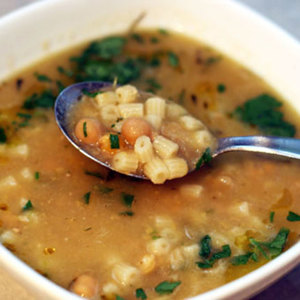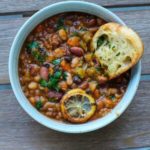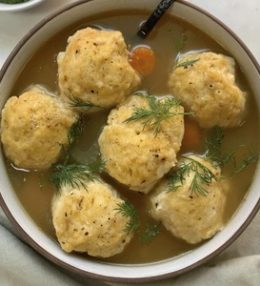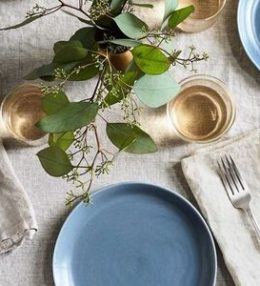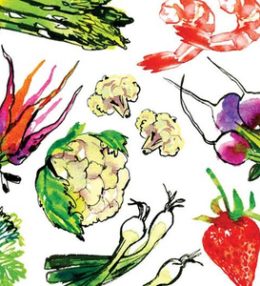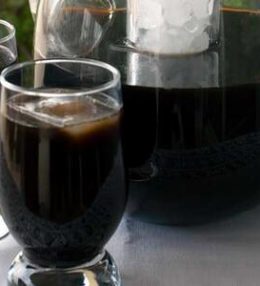
Why It Works
- Puréeing a portion of the chickpeas into the sauce base gives the dish body and creaminess.
- While this is not traditionally a tomato-heavy pasta, adding some tomato paste in with the aromatics gives the dish savory depth, as well as a touch of color.
- A little acidity in the form of white wine goes a long way to brighten up and balance this hearty stew.
There are few things more comforting than a steaming bowl of pasta and beans, or as I like to call it, a healing dose of starch on starch. Pasta and chickpeas are both staples in Italian cuisine, and depending on who you ask, pasta e ceci can be referred to as a soup, a stew, or a pasta dish. Given how cheap and filling both ingredients are, it makes sense that people have been cooking them together, in their own very specific way, practically forever. Some versions are brothy like a soup, while others resemble noodles in chickpea–studded sauce. Sometimes vegetables play a supporting role; sometimes meat sneaks into the pot. You can make it with short tubular shapes like ditalini, broken strands of long pasta, or one of the myriad other fresh or dried noodle shapes out there.
Serious Eats / Andrew Janjigian
And then there’s the chickpeas. I found recipes using canned or cooked dried chickpeas, served whole, smashed up, blended smooth, and every combination in between. I settled on two slightly different methods for pasta e ceci: one for using cooked dried chickpeas, and one for canned.
After simmering dried chickpeas in salted water with aromatics, the cooking liquid is flavorful and slightly thick from the starchy beans—this is liquid gold and does wonders for the overall creamy texture of whatever you make next. I found mashing some of the cooked chickpeas against the side of the pot, in combination with the viscous cooking liquid, made a perfectly thick stew-like base for the dish.
Canned chickpeas perform surprisingly well in this application and save hours of cooking time. You can achieve a similar substantial, creamy base (even without the starchy cooking liquid) by blending a small portion of the beans with some broth at the beginning of the one-pot meal. Ultimately, you should feel free to use whatever you have on hand.
It’s important for the chickpea-broth mixture to be loose enough that the dried pasta can be cooked in the same pot, but won’t absorb so much liquid that it will leave the dish looking dry (there aren’t many traditional Italian pasta recipes that are “one-pot” deals, but pasta e ceci is one of them).
As for those supporting vegetables, they didn’t end up making the cut; the chickpeas themselves, along with the stock or chickpea cooking liquid are plenty flavorful enough that the dish doesn’t require much assistance in that department. A spoonful of tomato paste provides a bump of umami and imbues the otherwise monochromatic tan dish with a pleasant rose-colored tint.
An off-heat swirl of good olive oil and a sprinkle of grated Pecorino cheese rounded out the earthy flavor of the chickpeas with a one-two punch of salty tang and peppery bite for a creamy, stick-to-your-ribs pasta e ceci.
March 2021
Pasta e Ceci (Pasta With Chickpeas) Recipe
-
1/4 cup (60ml) extra-virgin olive oil, plus extra for drizzling
-
4 medium garlic cloves (20g), lightly crushed
-
1 sprig fresh rosemary
-
Kosher salt
-
1/4 teaspoon red pepper flakes
-
2 tablespoons (30g) tomato paste
-
1/2 cup (120ml) dry white wine
-
3 cups (1 pound 2 ounces; 510g) cooked dry chickpeas or two (15-ounce; 425g) cans low-sodium chickpeas, drained and rinsed, divided (see note)
-
4 cups (950ml) chickpea cooking liquid, homemade chicken or vegetable stock, or store-bought low-sodium chicken stock, divided (see note)
-
1/4 teaspoon freshly ground black pepper
-
8 ounces (225g) small tubular pasta, such as ditalini
-
2 ounces (55g) finely grated Pecorino Romano cheese, plus extra for serving
-
In a large Dutch oven, heat oil over medium heat until shimmering. Add garlic and rosemary, season lightly with salt, and cook, stirring frequently, until garlic softens and turns golden, about 5 minutes. Add pepper flakes and continue to cook, stirring constantly, until fragrant, about 30 seconds. Add tomato paste and cook until tomato paste is fragrant and turns dark brick red, about 1 minute.
Serious Eats / Andrew Janjigian
-
Stir in wine, scraping up any browned bits with a wooden spoon. Bring to a simmer, and cook until wine has emulsified with olive oil and mixture is slightly reduced, about 2 minutes.
Serious Eats / Andrew Janjigian
-
If using cooked dry chickpeas: Stir in 1 cup (170g) chickpeas and 1 cup (240ml) chickpea cooking liquid. Using a potato masher or wooden spoon, mash chickpeas against the sides and bottom of the pot until completely broken down. Stir in the rest of the chickpeas and remaining 3 cups (710ml) cooking liquid (supplementing with stock or water as needed to reach 3 cups), and black pepper. Season with salt to taste. Proceed to Step 4.
If using canned chickpeas: Remove Dutch oven from heat; remove and discard rosemary sprig. Add 1 cup (170g) chickpeas and 1 cup (240ml) stock, and using an immersion blender, blend mixture until smooth, 1 to 2 minutes. (If you do not have a handheld immersion blender, transfer mixture to blender and blend until smooth, about 1 minute. Pour mixture back into Dutch oven.) Stir in remaining 2 cups (340ml) of chickpeas, 3 cups (710ml) stock, and black pepper. Season with salt to taste.
Serious Eats / Andrew Janjigian
-
Bring chickpea mixture to a boil over medium-high heat. Stir in pasta and cook, stirring frequently, until pasta is just shy of al dente (1 to 2 minutes less than the package directs, as the pasta will continue to cook off-heat), and liquid is reduced to a consistency that falls between soupy and saucy. Adjust consistency as needed with additional water, stock, or chickpea cooking liquid, keeping in mind that liquid will tighten up as it cools due to starch from the chickpeas.
Serious Eats / Andrew Janjigian
-
Remove from heat, add cheese, and stir rapidly to incorporate. Season with salt to taste. Divide between individual serving bowls (for the dried chickpea version, look out for the garlic cloves and rosemary sprig; remove and discard them), and drizzle each serving with olive oil. Serve, passing extra grated cheese at the table.
Serious Eats / Andrew Janjigian
Special Equipment
Dutch oven, immersion blender or countertop blender
Notes
If cooking dried chickpeas, you can follow our basic stovetop or oven methods for cooking beans, or if you have a pressure cooker, you can cook beans that way as well. If using cooked dried chickpeas, use reserved chickpea cooking liquid for the 4 cups (950ml) of liquid called for in this recipe; if you don’t have a full 4 cups of leftover cooking liquid, supplement with homemade vegetable or chicken stock, store-bought low-sodium chicken, or water to reach that volume. The body provided by the chickpea cooking liquid is sufficient to thicken the soup, so there shouldn’t be a need to blend any portion of the liquid and chickpeas.
If using canned chickpeas, use homemade or store-bought stock for the 4 cups of liquid, and follow the blending instructions as written. We don’t recommend using the liquid from the chickpea cans for making this recipe; it produces an overly thick and gloppy texture. And because salinity levels vary so much across brands of canned beans and chickpeas, using the liquid makes it hard to control the seasoning of the dish.
Make-Ahead and Storage
This dish is best enjoyed immediately. Leftovers can be refrigerated in an airtight container for up to 2 days. Reheat gently on the stovetop, adding a splash of stock or water to loosen the sauce.
Read More
- Chicken Tagine with Pistachios, Dried Figs, and Chickpeas
- Everything You Can Do with a Can of Chickpeas
| Nutrition Facts (per serving) | |
|---|---|
| 687 | Calories |
| 26g | Fat |
| 82g | Carbs |
| 28g | Protein |
Show Full Nutrition Label
×
| Nutrition Facts | |
|---|---|
| Servings: 4 | |
| Amount per serving | |
| Calories | 687 |
| % Daily Value* | |
| 26g | 33% |
| Saturated Fat 6g | 29% |
| 18mg | 6% |
| 985mg | 43% |
| 82g | 30% |
| Dietary Fiber 12g | 42% |
| Total Sugars 9g | |
| 28g | |
| Vitamin C 6mg | 30% |
| Calcium 296mg | 23% |
| Iron 7mg | 37% |
| Potassium 832mg | 18% |
| *The % Daily Value (DV) tells you how much a nutrient in a food serving contributes to a daily diet. 2,000 calories a day is used for general nutrition advice. | |
(Nutrition information is calculated using an ingredient database and should be considered an estimate.)
Why It Works Puréeing a portion of the chickpeas into the sauce base gives the dish body and creaminess.While this is not traditionally a tomato-heavy pasta, adding some tomato paste in with the aromatics gives the dish savory depth, as well as a touch of color.A little acidity in the form of white wine goes a long way to brighten up and balance this hearty stew. There are few things more comforting than a steaming bowl of pasta and beans, or as I like to call it, a healing dose of starch on starch. Pasta and chickpeas are both staples in Italian cuisine, and depending on who you ask, pasta e ceci can be referred to as a soup, a stew, or a pasta dish. Given how cheap and filling both ingredients are, it makes sense that people have been cooking them together, in their own very specific way, practically forever. Some versions are brothy like a soup, while others resemble noodles in chickpea–studded sauce. Sometimes vegetables play a supporting role; sometimes meat sneaks into the pot. You can make it with short tubular shapes like ditalini, broken strands of long pasta, or one of the myriad other fresh or dried noodle shapes out there. Serious Eats / Andrew Janjigian And then there’s the chickpeas. I found recipes using canned or cooked dried chickpeas, served whole, smashed up, blended smooth, and every combination in between. I settled on two slightly different methods for pasta e ceci: one for using cooked dried chickpeas, and one for canned. After simmering dried chickpeas in salted water with aromatics, the cooking liquid is flavorful and slightly thick from the starchy beans—this is liquid gold and does wonders for the overall creamy texture of whatever you make next. I found mashing some of the cooked chickpeas against the side of the pot, in combination with the viscous cooking liquid, made a perfectly thick stew-like base for the dish. Canned chickpeas perform surprisingly well in this application and save hours of cooking time. You can achieve a similar substantial, creamy base (even without the starchy cooking liquid) by blending a small portion of the beans with some broth at the beginning of the one-pot meal. Ultimately, you should feel free to use whatever you have on hand. It’s important for the chickpea-broth mixture to be loose enough that the dried pasta can be cooked in the same pot, but won’t absorb so much liquid that it will leave the dish looking dry (there aren’t many traditional Italian pasta recipes that are “one-pot” deals, but pasta e ceci is one of them). As for those supporting vegetables, they didn’t end up making the cut; the chickpeas themselves, along with the stock or chickpea cooking liquid are plenty flavorful enough that the dish doesn’t require much assistance in that department. A spoonful of tomato paste provides a bump of umami and imbues the otherwise monochromatic tan dish with a pleasant rose-colored tint. An off-heat swirl of good olive oil and a sprinkle of grated Pecorino cheese rounded out the earthy flavor of the chickpeas with a one-two punch of salty tang and peppery bite for a creamy, stick-to-your-ribs pasta e ceci. March 2021 Pasta e Ceci (Pasta With Chickpeas) Recipe 1/4 cup (60ml) extra-virgin olive oil, plus extra for drizzling 4 medium garlic cloves (20g), lightly crushed 1 sprig fresh rosemary Kosher salt 1/4 teaspoon red pepper flakes 2 tablespoons (30g) tomato paste 1/2 cup (120ml) dry white wine 3 cups (1 pound 2 ounces; 510g) cooked dry chickpeas or two (15-ounce; 425g) cans low-sodium chickpeas, drained and rinsed, divided (see note) 4 cups (950ml) chickpea cooking liquid, homemade chicken or vegetable stock, or store-bought low-sodium chicken stock, divided (see note) 1/4 teaspoon freshly ground black pepper 8 ounces (225g) small tubular pasta, such as ditalini 2 ounces (55g) finely grated Pecorino Romano cheese, plus extra for serving In a large Dutch oven, heat oil over medium heat until shimmering. Add garlic and rosemary, season lightly with salt, and cook, stirring frequently, until garlic softens and turns golden, about 5 minutes. Add pepper flakes and continue to cook, stirring constantly, until fragrant, about 30 seconds. Add tomato paste and cook until tomato paste is fragrant and turns dark brick red, about 1 minute. Serious Eats / Andrew Janjigian Stir in wine, scraping up any browned bits with a wooden spoon. Bring to a simmer, and cook until wine has emulsified with olive oil and mixture is slightly reduced, about 2 minutes. Serious Eats / Andrew Janjigian If using cooked dry chickpeas: Stir in 1 cup (170g) chickpeas and 1 cup (240ml) chickpea cooking liquid. Using a potato masher or wooden spoon, mash chickpeas against the sides and bottom of the pot until completely broken down. Stir in the rest of the chickpeas and remaining 3 cups (710ml) cooking liquid (supplementing with stock or water as needed to reach 3 cups), and black pepper. Season with salt to taste. Proceed to Step 4. If using canned chickpeas: Remove Dutch oven from heat; remove and discard rosemary sprig. Add 1 cup (170g) chickpeas and 1 cup (240ml) stock, and using an immersion blender, blend mixture until smooth, 1 to 2 minutes. (If you do not have a handheld immersion blender, transfer mixture to blender and blend until smooth, about 1 minute. Pour mixture back into Dutch oven.) Stir in remaining 2 cups (340ml) of chickpeas, 3 cups (710ml) stock, and black pepper. Season with salt to taste. Serious Eats / Andrew Janjigian Bring chickpea mixture to a boil over medium-high heat. Stir in pasta and cook, stirring frequently, until pasta is just shy of al dente (1 to 2 minutes less than the package directs, as the pasta will continue to cook off-heat), and liquid is reduced to a consistency that falls between soupy and saucy. Adjust consistency as needed with additional water, stock, or chickpea cooking liquid, keeping in mind that liquid will tighten up as it cools due to starch from the chickpeas. Serious Eats / Andrew Janjigian Remove from heat, add cheese, and stir rapidly to incorporate. Season with salt to taste. Divide between individual serving bowls (for the dried chickpea version, look out for the garlic cloves and rosemary sprig; remove and discard them), and drizzle each serving with olive oil. Serve, passing extra grated cheese at the table. Serious Eats / Andrew Janjigian Special Equipment Dutch oven, immersion blender or countertop blender Notes If cooking dried chickpeas, you can follow our basic stovetop or oven methods for cooking beans, or if you have a pressure cooker, you can cook beans that way as well. If using cooked dried chickpeas, use reserved chickpea cooking liquid for the 4 cups (950ml) of liquid called for in this recipe; if you don’t have a full 4 cups of leftover cooking liquid, supplement with homemade vegetable or chicken stock, store-bought low-sodium chicken, or water to reach that volume. The body provided by the chickpea cooking liquid is sufficient to thicken the soup, so there shouldn’t be a need to blend any portion of the liquid and chickpeas. If using canned chickpeas, use homemade or store-bought stock for the 4 cups of liquid, and follow the blending instructions as written. We don’t recommend using the liquid from the chickpea cans for making this recipe; it produces an overly thick and gloppy texture. And because salinity levels vary so much across brands of canned beans and chickpeas, using the liquid makes it hard to control the seasoning of the dish. Make-Ahead and Storage This dish is best enjoyed immediately. Leftovers can be refrigerated in an airtight container for up to 2 days. Reheat gently on the stovetop, adding a splash of stock or water to loosen the sauce. Read More Chicken Tagine with Pistachios, Dried Figs, and Chickpeas Everything You Can Do with a Can of Chickpeas Nutrition Facts (per serving) 687 Calories 26g Fat 82g Carbs 28g Protein Show Full Nutrition Label × Nutrition Facts Servings: 4 Amount per serving Calories 687 % Daily Value* 26g 33% Saturated Fat 6g 29% 18mg 6% 985mg 43% 82g 30% Dietary Fiber 12g 42% Total Sugars 9g 28g Vitamin C 6mg 30% Calcium 296mg 23% Iron 7mg 37% Potassium 832mg 18% *The % Daily Value (DV) tells you how much a nutrient in a food serving contributes to a daily diet. 2,000 calories a day is used for general nutrition advice. (Nutrition information is calculated using an ingredient database and should be considered an estimate.)
Dinner Tonight: Chickpea and Pasta Soup Recipe


